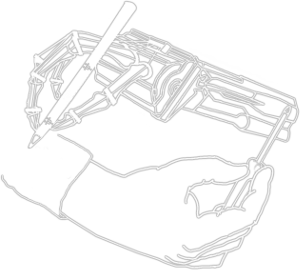Mechanisms of the anatomically correct testbed hand. Mechatronics, IEEE/ASME Transactions on 18, 238–250 (2013).
Novel design of a passive variable stiffness joint mechanism: Inspiration from biomechanics of hand joints. ASME 2013 Dynamic Systems and Control Conference V002T28A003–V002T28A003 (American Society of Mechanical Engineers, 2013).
A novel framework for virtual prototyping of rehabilitation exoskeletons. Rehabilitation Robotics (ICORR), 2013 IEEE International Conference on 1–6 (IEEE, 2013).
Statistical Functional Mapping From Body Parameters to Gait Kinematics. American Society of Biomechanics (2013).
Synthesis of Gait Kinematics Using a Database. Dynamic Walking (2013).
Contributions of intrinsic visco-elastic torques during planar index finger and wrist movements. Biomedical Engineering, IEEE Transactions on 59, 586–594 (2012).
Effects of moment arm variations on the joint stiffness characteristics of a musculo-tendon driven joint. ASME 2012 5th Annual Dynamic Systems and Control Conference joint with the JSME 2012 11th Motion and Vibration Conference 473–482 (American Society of Mechanical Engineers, 2012).
Muscle-tendon units provide limited contributions to the passive stiffness of the index finger metacarpophalangeal joint. Journal of biomechanics 45, 2531–2538 (2012).
Design of a motor-driven mechanism to conduct experiments to determine the passive joint properties of the human index finger. ASME 2011 International Design Engineering Technical Conferences and Computers and Information in Engineering Conference 615–622 (American Society of Mechanical Engineers, 2011).
Effects of Variations in Velocity on Viscoelastic Behaviour in the Metacarpophalangeal (MCP) Joint of the Human Hand. In Proceedings of American Society of Biomechanics (2011).
Acquiring variable moment arms for index finger using a robotic testbed. Biomedical Engineering, IEEE Transactions on 57, 2034–2044 (2010).
Contribution of passive properties of muscle-tendon units to the metacarpophalangeal joint torque of the index finger. Biomedical Robotics and Biomechatronics (BioRob), 2010 3rd IEEE RAS and EMBS International Conference on 288–294 (IEEE, 2010).
ACT hand finger control: muscle and joint torque control strategies. IEEE International Conference on Robotics and Automation (2009).
A methodology for design and analysis of cooperative behaviors with mobile robots. Autonomous Robots 27, 261–276 (2009).
Human motion modeling with a robotics method: analysis of a person riding a bus. ASME 2008 Dynamic Systems and Control Conference 647–652 (American Society of Mechanical Engineers, 2008).
Understanding variable moment arms for the index finger MCP joints through the ACT hand. Biomedical Robotics and Biomechatronics, 2008. BioRob 2008. 2nd IEEE RAS & EMBS International Conference on 776–782 (IEEE, 2008).
Behaviors for physical cooperation between robots for mobility improvement. Autonomous Robots 23, 259–274 (2007).
Control strategies and design guidelines for planar latch-less metamorphic robots based on analysis of dynamics. Intelligent Robots and Systems, 2007. IROS 2007. IEEE/RSJ International Conference on 4089–4095 (IEEE, 2007).
A method to characterize and exploit actuation redundancy in mobility and manipulation. Intelligent Robots and Systems, 2007. IROS 2007. IEEE/RSJ International Conference on 3515–3521 (IEEE, 2007).
A methodology for kinematics and dynamics analysis of robotic systems internal actuation. ASME 2007 International Mechanical Engineering Congress and Exposition 1361–1367 (American Society of Mechanical Engineers, 2007).
Behaviors for Physical Cooperation Between Robots for Mobility Improvement: Hardware Results and Use of Dynamics. Intelligent Robots and Systems, 2006 IEEE/RSJ International Conference on 2212–2218 (IEEE, 2006).
Development of Methodology for Design and Analysis of Physically Cooperating Robot and Applications to Other Robotic Systems. Proceedings of Robotics: Science and Systems (2006).
Intelligent Strategies for the Application of the Constraint Dominance Methods: Demonstration with Linear Motor Design Problem. Artificial Intelligence for Engineering Design, Analysis and Manufacturing (AIEDAM), Special Issue on Constraints and Design 20, 383–397 (2006).
A unified framework to represent physically cooperating mobile robots and other robotic systems. Robotics Science and System (2006).
Constraint Dominance Determination Methods. ASME 2003 International Design Engineering Technical Conferences and Computers and Information in Engineering Conference 553–563 (American Society of Mechanical Engineers, 2003).
Constraint Dominance Methods Applied to the Design of a Linear Synchronous Motor. International Design Engineering Technical Conference (2003).
Decentralized control for a team of physically cooperating robots. Intelligent Robots and Systems, 2003.(IROS 2003). Proceedings. 2003 IEEE/RSJ International Conference on 2, 1757–1762 (IEEE, 2003).
Enhancing mobility of a group of mobile robots via physical co-operation among the robots. Proceedings of SPIE conference on unmanned ground vehicle technology V (2003).
Pages
- « first
- ‹ previous
- 1
- 2
- 3


 ]
]